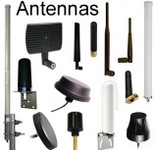Antennas, Antenna Cables, Wireless Products: Technical Articles
Coax Cable Types for Video and Audio: RG-59 and RG-179 BNC Cables
Coaxial Cables for CCTV, Video, Audio
Coaxial cables, commonly referred to as coax cables, have long been the standard in numerous connectivity applications. They're essential for transmitting radio frequency signals, which can include anything from your cable TV service to internet connectivity. Specifically, 75 Ohm coax cables is exceptionally versatile, and its application scope has only broadened with time.

BNC Cables and Their Multifarious Uses
One of the notable connectors for 75 Ohm coax cables is the Bayonet Neill-Concelman (BNC) connector. Initially designed for military use, BNC cables are now popularly associated with various applications:
- CCTV and Security Cameras: One of the hallmark applications of BNC extension cables is in the realm of closed-circuit television (CCTV) and security cameras. Their ability to transmit video signals over long distances without significant degradation makes them a prime choice for surveillance systems.
- Video: Beyond security systems, BNC 75 Ohm cables and BNC adapters serve a significant role in transmitting video signals in professional broadcasting.
- Audio: Though less common, BNC male to male cables can be employed in specific audio applications, particularly in professional setups where signal integrity is paramount.
Key Features of 75 Ohm Coax Cables

- Signal Integrity: One of the strengths of coax cables is their resilience against interference, ensuring that signals remain strong over long distances.
- Durability: Their design, which typically includes a central conductor, an insulating layer, a metal shield, and an outer layer, ensures they're robust and durable.
- Versatility: Suitable for both analog and digital signals, they're adaptable to various needs, from vintage audio equipment to cutting-edge broadcasting tools.
Composition and Materials
The makeup of coax cables plays a crucial role in their functionality:
- Central Conductor: Typically made of solid or stranded copper, this is where the main signal travels.>
- Insulation: Surrounding the conductor, this layer often consists of polyethylene or similar materials to prevent signal leakage.
- Shielding: Made of metal, often braided copper or aluminum, this layer prevents external interference.
- Outer Jacket: Provides the final layer of protection, generally crafted from PVC or similar materials.
Types of Coax Cables
While there are several types of coax cables, for 75 Ohm applications, the most common include:
- RG-59: Commonly used for CCTV and other video applications.
- RG-179: CCTV and other video applications. Thinner and more flexible than RG-59.
- RG-6: A popular choice for cable TV and satellite.
- RG-11: Optimal for long-distance runs due to its larger core.
In Conclusion
The resilience of 75 Ohm coax cables, especially when equipped with BNC connectors, demonstrates their versatility across eras and technologies. From the days of traditional broadcasting to the cutting-edge world of IoT, they have retained their significance, proving that sometimes, the old ways can seamlessly integrate into the future.







